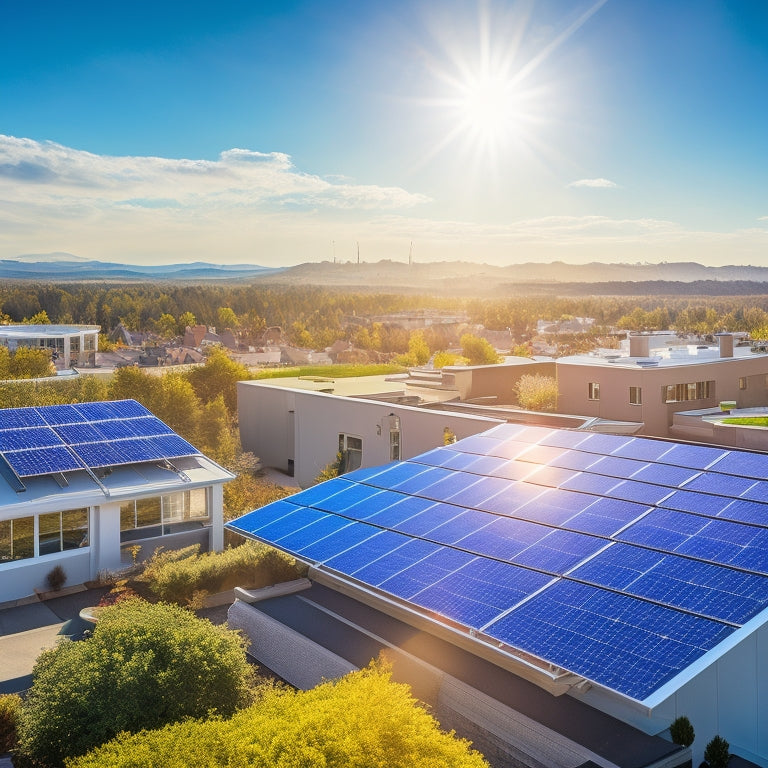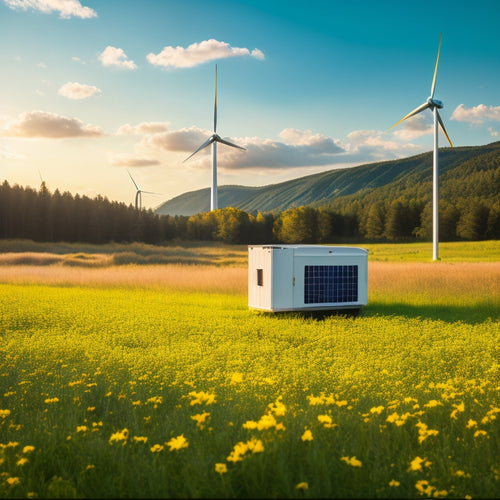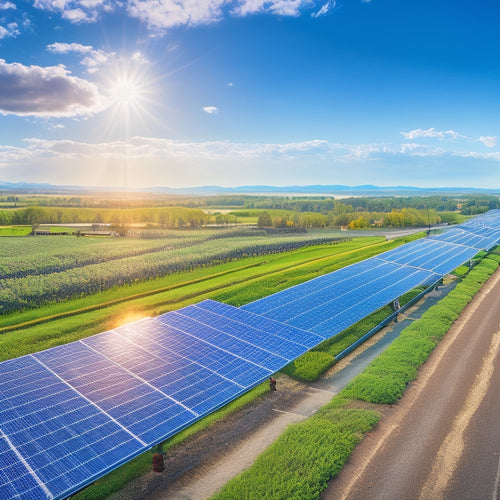
Top High Power Solar Panels for Residential and Commercial Use
Share
High power solar panels are essential for maximizing energy efficiency in both residential and commercial settings. You should focus on high-efficiency options like monocrystalline and bifacial panels, which convert sunlight at rates of 15-24%. These panels not only save space but also deliver significant cost savings over time through reduced electricity bills and available incentives. To determine your ideal system, assess your energy needs and anticipate future consumption patterns. By strategically placing panels and maintaining them, you'll enhance performance. Investigate how advancements in technology can further improve your solar investment potential.
At a Glance
- Maximize energy output by selecting high-efficiency solar panels, such as monocrystalline or bifacial options, for superior performance and longevity.
- Optimize panel placement by positioning them towards true south or true north and analyzing shading for maximum sunlight exposure.
- Calculate energy consumption accurately to size solar panels effectively, aligning with both current and future energy needs.
- Take advantage of long-term savings and incentives, reducing electricity bills and enhancing energy independence over time.
- Utilize compact high power solar panels to maximize output per square foot, ideal for urban settings or limited installation spaces.
Maximize Energy Efficiency
To maximize energy efficiency in high power solar panels, you'll want to focus on energy output optimization and effective panel placement strategies.
By analyzing the specific conditions of your installation site, you can greatly enhance the energy harvested from sunlight. Implementing these strategies not only elevates performance but also guarantees a quicker return on your investment.
Additionally, considering advancements in solar technology can lead to improved energy conversion rates, thereby raising the overall efficiency of your solar system increased efficiency benefits.
Energy Output Optimization
How can you guarantee that your high power solar panels operate at peak efficiency? Start by leveraging the latest solar technology advancements.
These innovations not only increase the panels' energy conversion rates but also enhance their durability and performance under varying weather conditions. By selecting panels with high efficiency ratings, you ascertain that you capture more sunlight and convert it into usable energy.
Next, consider integrating energy storage solutions.
These systems allow you to store excess energy generated during peak sunlight hours, which can be employed during periods of low sunlight or high demand. This means you won't have to rely solely on the grid, enabling you with greater control over your energy consumption.
Regular maintenance is also crucial.
Keeping your panels clean and free from debris maximizes their exposure to sunlight, further optimizing energy output. Additionally, monitoring your solar system's performance regularly enables you to identify any inefficiencies and address them promptly.
Panel Placement Strategies
Ideal panel placement is crucial for maximizing the energy efficiency of high power solar panels. To achieve peak performance, you need to take into account the panel orientation and conduct a detailed shading analysis. The angle at which your panels are installed greatly impacts their energy output.
Ideally, you should position your panels to face true south in the Northern Hemisphere or true north in the Southern Hemisphere, maximizing sun exposure throughout the day.
Before installation, perform a shading analysis to identify potential obstructions, such as trees or buildings, that could block sunlight. Even partial shading can drastically reduce energy production, so it's essential to address these issues at the outset.
You might also want to take into account adjusting the tilt angle of your panels, as this can improve energy capture during different seasons.
Additionally, avoid placing panels in areas with high ambient light interference or pollution. By strategically planning your panel orientation and conducting a thorough shading analysis, you can utilize the full potential of your high power solar system.
This proactive approach not only enhances efficiency but also guarantees you get the most out of your investment in renewable energy.
Cost Savings Over Time
Investing in high power solar panels can lead to significant long-term energy savings. By capturing solar energy, you can drastically reduce your electricity bills, allowing for a quicker return on investment.
Additionally, government incentives can help mitigate initial financial burdens, making solar solutions even more accessible. Over time, these cost savings can accumulate, enhancing your financial stability and energy independence.
Long-term Energy Savings
When you consider the long-term energy savings offered by high power solar panels, the financial benefits become clear. Investing in solar technology isn't just a one-time expense; it's a strategic solar investment that pays dividends over the years. By utilizing sunlight, you greatly reduce your reliance on conventional energy sources, clearing the path for energy independence.
High power solar panels have longer lifespans and higher efficiency rates, which translate to greater energy output over time. This efficiency means that you can generate more electricity, thereby maximizing your returns on investment. Additionally, as energy prices continue to rise, your solar system acts as a buffer against fluctuating utility costs, ensuring that your financial future remains stable.
Moreover, the initial costs of solar panel installation are often offset by available incentives, tax credits, and financing options, making it easier for you to adopt this technology. The true value is realized over the long haul, as you enjoy lower overall energy expenditures.
Essentially, high power solar panels not only contribute to your financial well-being but also enable you with the freedom that comes from sustainable living.
Reduced Electricity Bills
High power solar panels greatly reduce electricity bills, providing considerable cost savings over time. By utilizing the sun's energy, you minimize your reliance on traditional utility providers, effectively decreasing your monthly expenses. Over the lifespan of your solar system, which often exceeds 25 years, these savings can accumulate greatly.
Moreover, many states offer solar incentives, including tax credits and rebates, which can further offset initial installation costs. This means you'll not only save on electricity bills but also benefit from financial support when you invest in solar technology.
Additionally, utility partnerships may provide net metering options, allowing you to sell excess energy back to the grid. This creates an even greater potential for savings and possibly generates income.
As your energy independence grows, you'll find more freedom in your financial planning. The combination of reduced monthly bills and available incentives can lead to a rapid return on investment, making high power solar panels a wise choice for both residential and commercial applications.
Panel Efficiency Ratings
When selecting solar panels, understanding efficiency ratings is essential for maximizing energy output.
Various factors, such as temperature and shading, greatly affect a panel's efficiency, impacting your overall system performance.
Additionally, factors like humidity challenges can lead to degradation and reduced efficiency in solar cells.
Understanding Efficiency Ratings
Evaluating solar panel efficiency ratings is vital for determining the effectiveness of solar energy systems. These ratings reflect how well a panel converts sunlight into usable electricity, and they're essential for making informed decisions. You'll find that advancements in solar technology have led to improved efficiency ratings, enhancing the overall performance of solar panels.
When comparing different models, it helps to apply efficiency comparison metrics. Here's a quick reference table to illustrate efficiency ratings across various panel types:
| Panel Type | Efficiency Rating (%) | Solar Technology Advancements |
|---|---|---|
| Monocrystalline | 15-22% | Higher purity silicon, better design |
| Polycrystalline | 13-17% | Improved manufacturing processes |
| Thin-Film | 10-12% | Flexible materials, lightweight |
| Bifacial | 18-24% | Dual-sided light absorption |
Factors Affecting Efficiency
Several factors play an essential role in determining the efficiency of solar panels. First, the type of solar technology used greatly influences performance. Monocrystalline panels, for instance, typically offer higher efficiency ratings than polycrystalline options due to their superior purity of silicon.
You'll also want to take into account the temperature coefficient; as temperatures rise, many panels lose efficiency.
Next, the design and orientation of the panel affect how much sunlight it can capture. Proper angling toward the sun can maximize exposure, while shading from trees or buildings can drastically reduce energy production.
Additionally, the quality of materials impacts longevity and performance. Higher-quality components generally yield better efficiency over time, enhancing your investment's overall return.
Assess Your Energy Requirements
To determine the right high power solar panels for your needs, start by calculating your current energy consumption.
Conducting an energy audit will help identify inefficiencies and provide a clearer illustration of your requirements. Evaluating your daily and monthly usage will provide a clear illustration of your requirements.
Additionally, consider any future energy needs, such as new appliances or expansions, to guarantee your solar system can accommodate growth.
Calculate Energy Consumption
Understanding your energy consumption is vital for determining the right high power solar panels for your needs. Start with an energy audit to analyze your current usage. This process involves evaluating your consumption patterns over a typical month to identify peak usage times and the overall energy demand.
By gathering data on how much electricity you consume, you can make informed decisions about the solar panel capacity required to offset your energy bills.
Take note of specific appliances and systems that require significant power. For example, heating, cooling, and large kitchen appliances often contribute to high usage. Understanding these patterns allows you to pinpoint when and how much energy you need, which is essential for sizing your solar panel system accurately.
Once you've assessed your energy consumption, you can calculate the total wattage required and match it with the appropriate high power solar panels. This guarantees you generate enough electricity to meet your demands and potentially achieve energy independence, allowing you the freedom to utilize renewable energy effectively.
Ultimately, knowing your energy consumption is the first step toward a sustainable solar solution customized to your lifestyle.
Evaluate Future Needs
After you've assessed your current energy consumption, it's important to contemplate your future needs. As technology evolves, so do your energy requirements.
Consider potential changes in your household or business—like adding new appliances, expanding your facilities, or adopting electric vehicles. These factors can greatly impact your energy usage.
You should also keep an eye on market trends. The rise of smart home devices and energy-efficient technologies may alter how you consume power.
Future technology, such as battery storage systems and advanced solar panel configurations, can optimize your energy management. By understanding these trends, you can better predict your energy needs over the next decade.
When evaluating your future requirements, think about your lifestyle and business goals. Are you aiming for sustainability? Do you plan to increase your energy independence?
Aligning your solar panel investment with these aspirations can enable you in the long run.
Ultimately, preparing for future energy demands allows you to make informed decisions today. By anticipating your needs and staying updated on advancements, you'll guarantee that your solar energy system remains efficient and effective for years to come.
Higher Output per Square Foot
When considering solar panels, higher output per square foot is essential for maximizing your energy production.
This efficiency allows you to generate more electricity without requiring additional space, which is particularly beneficial for urban settings or limited rooftops.
Understanding how these high power panels optimize space can greatly influence your overall energy strategy.
Space Efficiency Benefits
High power solar panels greatly enhance space efficiency by providing a higher output per square foot compared to traditional panels. When you're looking to maximize space utilization, these panels are a revolutionary innovation. Their compact designs allow you to install them in areas where conventional panels simply wouldn't fit, making them ideal for both residential and commercial applications.
Here's a comparison of space efficiency between traditional and high power solar panels:
| Panel Type | Output per Square Foot (W) |
|---|---|
| Traditional Panels | 15-20 |
| High Power Panels | 20-25 |
| Compact Panels | 25-30 |
| Ultra-High Power | 30+ |
| Standard Efficiency | 10-15 |
As shown, high power panels not only offer superior energy production but also make the most of limited roof space or small installations. This increased efficiency can lead to reduced installation costs and a lower carbon footprint. You'll find that investing in high power solar panels is a strategic move toward energy independence, allowing you to utilize maximum solar energy without sacrificing your available space.
Frequently Asked Questions
How Long Do High Power Solar Panels Typically Last?
High power solar panels typically last 25 to 30 years. Their lifespan depends on durability factors like material quality, environmental conditions, and maintenance. Understanding these elements helps you maximize your investment and energy independence.
Are High Power Solar Panels Suitable for All Roof Types?
Did you know that nearly 80% of roofs are compatible with solar installations? However, roof compatibility and installation considerations vary. You'll need to assess structure, angle, and material before deciding on high power solar panels.
What Is the Warranty Coverage for High Power Solar Panels?
When considering high power solar panels, you should review warranty terms carefully. Coverage details typically include performance guarantees and equipment defects, ensuring your investment is protected against potential issues over time.
Can I Install High Power Solar Panels Myself?
While DIY installation offers freedom, it's not without challenges. You'll face installation difficulties and must prioritize safety. If you're skilled and cautious, it's doable; otherwise, consider professional help to guarantee peak performance and safety.
How Do I Maintain High Power Solar Panels?
To maintain high power solar panels, use effective cleaning techniques to remove debris and dirt. Regular inspections guarantee peak performance optimization, allowing you to utilize maximum energy and enjoy the freedom of sustainable energy independence.
Explore More
In choosing high-power solar panels, you're not just investing in energy efficiency; you're also creating opportunities for long-term savings. Did you know that the most efficient panels can convert over 22% of sunlight into usable energy? This means you're utilizing more power in less space, maximizing your return on investment. By evaluating your energy needs and selecting the right panels, you're not only reducing your carbon footprint but also greatly lowering your utility bills over time.
Related Posts
-

Sustainable and Eco-Friendly Generators for a Reduced Carbon Footprint
Sustainable and eco-friendly generators are perfect for cutting your carbon footprint and increasing energy efficienc...
-

Applications of Photovoltaic Systems
Photovoltaic systems are versatile, converting sunlight into electricity for various applications. You can use them i...
-

Solar Powered Lights for Sustainable Home Decor
Solar-powered lights offer a stylish and eco-friendly way to enhance your home decor. They capture sunlight, converti...


